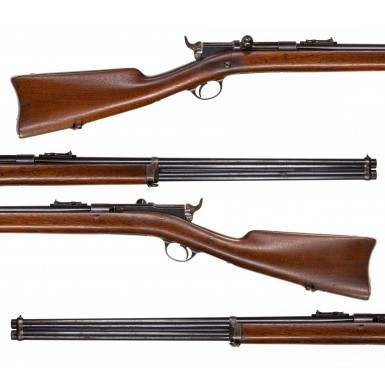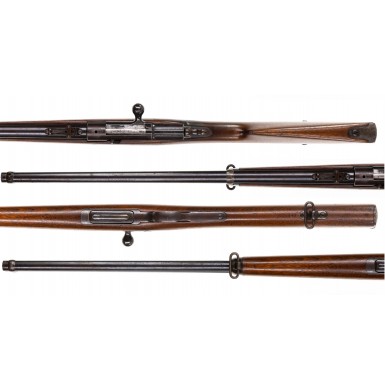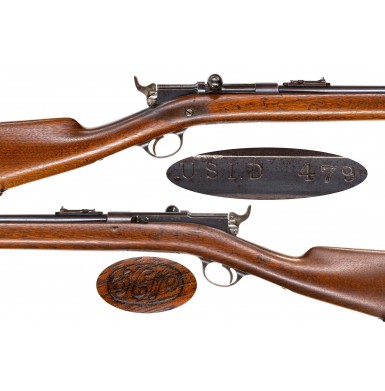Extremely Rare & Fine Remington-Keene US Indian Police Frontier Rifle
- Product Code: FLA-3875-SOLD
- Availability: Out Of Stock
-
$6,995.00
This is a VERY FINE condition example of the rare Remington-Keene Frontier Rifle purchased by the US Department of the Interior for use by the Bureau of Indian Affairs Tribal Police. The Bureau of Indian Affairs is one of the oldest departments of the US government and was officially established in 1824 as a bureau within the Department of War. Prior to establishment of the official “bureau”, a “commissioner,” who was appointed by the President, handled the affairs and relationships between the US government and the various indigenous tribes that inhabited the states and territories of the United States. This commissioner reported directly to the President and Congress. William Clark, of the famous Lewis & Clark “Corps of Discovery” expedition, was one of the first commissioners to hold that position, under President Thomas Jefferson. In 1849 the Bureau of Indian Affairs was transferred from the War Department to the newly established Department of the Interior. Initially the Bureau of Indian Affairs (B.I.A.) was responsible for regulating trade with the various Native American nations, buying land from the native people, negotiating treaties, supervising the payouts of annuities guaranteed by the treaties, etc. However, as the 19th century progressed, the B.I.A. became more involved with management of the newly established reservations that many of the tribes were removed to. The B.I.A. oversaw the delivery of government provisions and subsidies to the Indians on the reservations and supervised, although often poorly, the agents appointed to be the government representatives on those reservations. As the reservations grew, so did the need for reservation specific law enforcement agencies to keep the peace, settle disputes, and capture criminals. By the mid-19th century many Indian Agents had established ad-hoc local police forces, made up local reservation Indians who were willing to “enforce the law” as established by the reservation agent. Often these groups were not uniformed and were poorly equipped, relying on local army outposts for any weapons that could be spared.
In 1878 the B.I.A. established an official Indian Police force, under the direct control of the bureau, thus taking the control of the policemen away from unscrupulous Indian Agents who occasionally used their ad-hoc police as reservation “enforcers”. The new system meant that reservation law enforcement now had a budget and would be supplied and regulated by Washington. It also meant regular monthly pay for the Indian police, although at between $5 and $8 per month, it was certainly quite low, especially when the pay of a private in the Union Army during the Civil War, more than a decade earlier, had been $13 per month. By the end of the first year of implementation some 22 of the 68 Indian Agencies had their own B.I.A. police force and by 1890 59 of the 68 agencies would have Indian Police. The new police force often drew its members from the traditional tribal law enforcement societies. Among the Lakota people, those who had held the traditional tribal “police” position had been known as Aki’citas. These hand-selected men, the most honorable and preeminent within the various warrior societies of the Lakota provided security and organizational control during the buffalo-hunting season. In 1879, many of the former Aki’citas on the Pine Ridge Reservation in South Dakota joined the newly formed Indian Police, continuing their traditional roll of protecting and caring for their people. Federal control of the police also meant official equipment and uniforms. The uniforms basically followed the style and type issued to Indian Scouts working for the US Army on the frontier, with the primary uniform article being a 5-button fatigue blouse of dark blue wool, and an Indian Police badge. The supply of weapons to the Indian Police was somewhat inconsistent and not nearly as standardized as the uniforms, but in 1880 the US Department of the Interior did purchase some 650 Remington Model 1875 Single Action Army Revolvers and 600 Remington-Keene Frontier Rifles for issue to the Indian Police.
Probably the most infamous day in the history of the B.I.A. Tribal Police was 16 December 1890 when the Indian Police botched an attempt to arrest the great Hunkpapa Sioux chief Sitting Bull at his home on the Standing Rock Reservation in North Dakota. A group of Sitting Bull’s supporters tried to intervene in the arrest, and some 150 of the chief’s followers confronted the 43 Indian Police. In a matter of minutes the attempted arrest turned into a maelstrom of bullets that left 14 people dead including Sitting Bull, 7 of his supporters and 6 Indian Policemen. The wounded included 3 more supporters and 1 additional policeman.
The choice of the Remington-Keene Frontier Rifle for use by the Indian Police is an interesting one. It may have been motivated by the decision to purchase the Model 1875 revolvers from Remington, with the theory that adding long arms to the same order might improve the pricing on the entire purchase. When the order was placed in 1880, the Remington-Keene Magazine Bolt Action Rifle was the only repeating rifle offered by Remington that was not a revolving firearm. Remington had concentrated on the development and marketing of its rolling block series of single-shot rifles at the conclusion of the American Civil War and had not actively pursued the development of a repeating rifle. With the announcement that the US Army was convening a “Magazine Gun Board” to hold trials for a repeating rifle design in 1878, Remington was left scrambling for a potential submission. They obtained the rights to a series of patents held by New Jersey gun designer John W Keene. Keene’s design was for a bolt-action repeating rifle with a tubular magazine located under the barrel. The design included a magazine cut-off on the left side of the receiver, allowing the rifle to be used as a single shot and saving the cartridges in the magazine for “emergencies” when rapid fire was essential. The bolt had an external cocking piece that resembled a conventional hammer, which made it easy for anyone handling the gun to know immediately if the rifle was cocked or not. Keene’s simple, yet sturdy bolt action design was well adapted to use with the large .45-70 Government cartridge that was specified for the Army rifle trials. Lever action rifles of the late 1870s had yet to be designed that had strong enough actions and that would function reliably with that cartridge, so the Remington team felt their bolt-action repeater would have a significant advantage over other competing designs. Of the rifles submitted for trial in 1878, the lever action designs faired quite poorly, as did experimentally altered Springfield Model 1873 “Trapdoor” rifles with tubular magazines in the buttstock. However, the bolt-action designs submitted by Remington, Winchester, Colt and Sharps all acquitted themselves very well. In the end the Winchester-Hotchkiss was the winning design, but the design Remington did receive mostly favorable marks, especially for the external hammer shaped cocking lever. Although the trials did not produce the desired Army contract, the rifle did well enough that the Navy ordered 250 of the rifles early in 1880 to issue experimentally, alongside the already adopted Winchester-Hotchkiss Rifles and an equally experimental design by James Lee. This order may have convinced the Department of the Interior to try the Remington-Keene design as well, as they placed their order for 600 “Frontier” models in July of that same year. The Navy variant of the Remington-Keene had a 29 ¼” round barrel, and a 9-round tubular magazine under the barrel. Unlike most Remington-Keene models, the magazine was mostly enclosed in a wooden forend. The Department of the Interior “Frontier” variant was a mixture of carbine and rifle features, with a 24” round “rifle” length barrel with an 8-round tubular magazine, a carbine style buttplate and front barrel band, and military rifle style sling swivels on the forend cap and under the toe of the stock. Both rifles were chambered for the .45-70 Government cartridge. In both cases the barrels and receivers and some furniture were blued, the “hammers” and buttplates were case hardened and the bolt body was left in the white. Lt. William W. Kimball of the US Navy conducted the inspection of the Navy contract Remington-Keene rifles and marked their receivers with his initials as well as a “US” a “P” and a naval anchor stamp. Kimball also did the initial inspections of the Interior Department Remington-Keene rifles, again marking the receiver with his “WWK” initials and a “P” mark but using an feathered arrow instead of an anchor. The Department of the Interior guns were then further inspected by Springfield Armory sub-inspector Henry Nettleton, who placed his initials on the left side of the barrel and the receiver at their juncture, and his cartouche on the left wrist of the stock. The guns were additionally marked on the left side of the receiver U.S.I.D. for United States Interior Department followed by a serial number from 1 to 600.
Remington saw the sales of 850 of the Remington-Keene arms to the US government as a fortuitous indicator of future sales and went into production with a civilian variant in rifle with a 24 ¼” barrel and a carbine version with a 22” barrel. The guns were offered in the standard .45-70 government chambering as well as .43 Spanish and .40-60. In the end, the design languished and did not sell well. Between 1880 and 1883, less than 5,000 of all the Remington-Keene variants were produced and Remington dropped the design from their product line. There were no significant issues with the design, but it was not particularly remarkable either. The result was lackluster sales, thus Remington decided to pursue their more successful bolt action design, the Remington-Lee.
As previously noted, this is a VERY FINE example of a US Department of the Interior marked Indian Police issue Remington-Keene Frontier Rifle. The left side of the receiver is crisply marked in a single line U.S.I.D. 479, and the left side of both the receiver and the barrel are crisply marked with Henry Nettleton’s HN. mark. The left wrist of the rifle shows a very crisp and clear, script HN cartouche. The top of the receiver is crisply marked P / W.W.K. to the rear of the gas escape port, and with a B.I.A. {ARROW} mark forward of the gas port. The top of the bolt is marked in three lines:
E. REMINGTON & SONS. ILION, N.Y.
PAT. FEB’Y 24 MCH. 17, 1874 JAN 18
SEPT 26 1876 MCH. 20 JULY 31, 1877
The rifle is 100% complete, correct, and original in every way. The gun retains about 70%+ of its original blued finish on the 24” round barrel, magazine tube and receiver, with much of that blue remaining vivid and vibrant. The gun shows moderate use and wear, but no abuse. The finish shows moderate thinning and wear along the high edges and points of contact and has developed a mostly smooth plum-brown patina in most of the areas where the finish is light or worn. The metal shows scattered areas of freckled surface oxidation over the entire rifle, and a few patches of more significant oxidation and some small areas of light to moderate surface roughness along the barrel. Most of these areas are about the size of finger or thumbprints and are likely the result of handling over 130+ years of use. There is a more moderate area of surface oxidation and roughness that on the obverse of the rifle in the recess between the barrel and magazine tube that is about 3” in length. The muzzle shows some light pitting as well, as would be expected. The barrel and magazine tube show a few minor scrapes and dings, not uncommon for an old-west era shoulder arm that was likely transported on horseback for hundreds of miles. The hammer shaped cocking piece retains only the most minor traces of its original case coloring and has a mostly dull gray patina with speckled oxidation, age discoloration and light surface pinpricking. The case hardened buttplate and forend cap have the same smoky gray patina with traces of case coloring as the hammer does. The bright areas of the bolt show the same dulling to the metal with scattered patches of oxidized discoloration as well.
The rifle is mechanically excellent and functions smoothly and correctly in every way. The magazine cut-off switch functions perfectly as well, and smoothly moves between the on and off positions. The bore of the rifle is in about VERY GOOD+ condition. It is mostly bright and retains crisp, deep rifling. The bore shows light to moderate pitting scattered along its entire length, with the most noticeable area of pitting a few inches from the muzzle. The original military ladder style rear sight is in place on the barrel, just in front of the receiver. It is complete and fully functional. The original drift adjustable front sight blade is in place near the muzzle as well. The rifle also retains both of its original sling swivels, one on the forend cap band and the other in the toe of the stock, near the butt plate. The stock of the rifle rates about VERY FINE as well. It is solid, complete, and full length with no breaks or repairs. The stock shows no signs of sanding and appears uncleaned. It retains an excellent script HN Henry Nettleton inspection cartouche on the reverse wrist. The Remington-Keene stock design is notoriously weak in the wrist area, and most surviving examples show major cracks, breaks and repairs in that area. This rifle shows only a minor hairline grain crack running along the right side of the rifle, below the receiver from the tang towards the stock bolt. This appears to be a surface grain crack that is crisp, tight and quite stable and only about 2” in length. It is barely noticeable, non-structural, and mentioned for exactness and correctness in the description. The stock does show the usual expected scattered bumps, dings, minor scrapes, and mars that are expected to be found on a government service weapon, but no excessive wear, damage or abuse is noted.
Overall, this is really an outstanding example of an extremely rare US Interior Department Indian Police Rifle. These guns saw hard use on the reservations during the 1880s, and no doubt some remained in use well past the turn of the century. When these rare rifles are found for sale they are often devoid of finish and usually look like they have been drug in the mud behind a buffalo. US Indian Police marked and used arms are extremely rare and incredibly desirable collectibles. This wonderful example of a U.S.I.D. marked rifle would be extremely difficult to upgrade and will not doubt be a centerpiece in a very advanced collection of arms from the American West. Whether you specifically collect Indian Police items, law enforcement items from the old west or are an advanced Remington collector, you are not likely to have a chance to purchase an Indian Police Remington-Keene rifle in this condition any time again in the near future. As an example of the way the rifle would have looked in use, a picture of US Indian Policeman Black Coyote is included at the end of the photos of this gun, posing in his Indian Police uniform with his Remington-Keene US Interior Department Frontier Rifle.
SOLD
Tags: Extremely, Rare, Fine, Remington-Keene, US, Indian, Police, Frontier, Rifle














